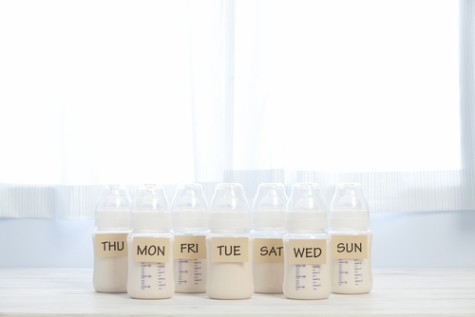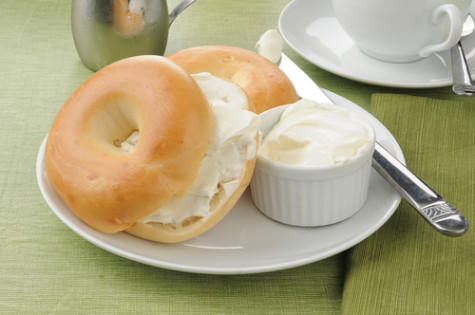 Breastfeeding is often sold to new mothers as a bulletproof way to lose the baby weight. The promise is the same whether you’re getting advice from lactation experts, mummy blogs, Unicef, midwives, or official medical sites such as the NHS in the UK and the National Institutes of Medicine in the US: feed your baby the natural way, and you’ll burn about 500 calories every day.
Breastfeeding is often sold to new mothers as a bulletproof way to lose the baby weight. The promise is the same whether you’re getting advice from lactation experts, mummy blogs, Unicef, midwives, or official medical sites such as the NHS in the UK and the National Institutes of Medicine in the US: feed your baby the natural way, and you’ll burn about 500 calories every day.
The prospect of effortlessly melting away the baby weight will be attractive to someone who is probably still too sore and exhausted from labour to even consider going for a run. It’s also an awfully nice carrot to dangle in front of a person who is on the fence about breastfeeding. But 500 calories is a very specific number. So where did it come from? And is there any truth in it?
It’s certainly truthy. You may know someone who became her leanest when nursing her infant even as she ate whatever she pleased. That just makes sense: it’s calorically expensive to make a nutritious substance that delivers calories to another person. Every 100 milliletres of human milk – which constitutes 3 to 5 percent fat, 7 percent carbohydrates, two types of protein (whey and casein), vitamins, minerals, fatty acids, and white blood cells – contains 60 to 75 calories.
Multiply that by the volume of milk a baby drinks (on average about 750 ml a day) and you get to 450 to 560 calories a day. Following a straight calories-in-calories-out interpretation, this is how many calories leave the nursing mother’s body.
 This was the maths at the heart of one of the first studies of the caloric cost of nursing to mothers, done in 1997 by Kathryn Dewey and colleagues at the University of California Davis. Dewey’s number was actually a bit higher; the authors took into account breast milk volume, milk energy density and the conversion efficiency from dietary energy to breast milk to conclude that exclusive breastfeeding ups a woman’s baseline energy needs by 670 calories a day. Which means either she needs to eat more to keep up, or her body will reach into its fat stores. To allow for gradual weight loss, drop that number to about 500 calories. And a viral fact was born.
This was the maths at the heart of one of the first studies of the caloric cost of nursing to mothers, done in 1997 by Kathryn Dewey and colleagues at the University of California Davis. Dewey’s number was actually a bit higher; the authors took into account breast milk volume, milk energy density and the conversion efficiency from dietary energy to breast milk to conclude that exclusive breastfeeding ups a woman’s baseline energy needs by 670 calories a day. Which means either she needs to eat more to keep up, or her body will reach into its fat stores. To allow for gradual weight loss, drop that number to about 500 calories. And a viral fact was born.
A handful of other studies seemed to confirm the number. Many of them relied on women’s self-reported food diaries. The authors of one representive study found that women who breastfed tended to consume, on average, about 500 calories per day more than women who artificially fed their children. The conclusion was that that the women were unknowingly making up for a deficit.
And in 2008 a very large Danish study associated breastfeeding with greater weight loss at 6 months post-partum.
This collection of studies is a bit like an impressionist painting. From a certain distance, all the dots seem to join to paint one coherent picture: breastfeed and you will burn 500 calories a day which will return you to your pre-pregnancy weight. Zoom in on any single study, however, and the details lose coherence.
The first, and most glaring, problem is that most of these studies are indirect. The researchers either based their conclusions on mathematical assumptions or self-reports.
If you wanted to know exactly how lactation changes a woman’s energy requirements, you’d need to undertake a different experiment. You’d have to measure their basal metabolic rate (BMR) before they got pregnant — at several different times of day — and then measure it again once they were breastfeeding. BMR can be measured in the lab via respirometry – in which you look at the amount of oxygen burned, a good proxy for how much energy your body derives from its fuel. Then you could observe how many calories breastfeeding burned for a specific woman.
Instead, many breastfeeding studies rely on self-reports and surveys (which can be minefields for misinterpreting or manipulating data). “It’s very difficult to get good data on sleep deprived mothers,” says Peter Hartmann, who studies lactation at the University of Western Australia.
Another problem: it is not a foregone conclusion that nursing mothers eat more strictly to make up for a deficit. There are a thousand other possible reasons. The thirst generated by the milk-producing hormone PYY can be mistaken for hunger. Sleep deprivation factors heavily in poor food choices. The newly sedentary life as on-demand milk machine might play a role. As might the stress of dealing with a new baby. And certainly, no measuremements of how much extra women are consuming justify any conclusions about the number of calories they are burning.

The biggest problem, however, is with the meaningfulness of the “500 calories”. They are not burned. They are transferred. This is an important but subtle distinction.
If the calories were all “burned” during milk production, this would have effects on a woman’s BMR similar to a regular 5-mile-run. Her metabolism would shoot up and she would need to eat more food.
By contrast, simply transferring the milk to the infant does not raise her BMR. According to Hartmann, “only about 10 percent of the energy cost of milk production is burnt up synthetizing milk, and would show up in resting metabolic rate measurements, whereas milk in the breast does not.”
In fact, there is evidence that the mother’s metabolism may slow down to accommodate the new energy drain. When doing the math in her seminal paper, Dewey explicitly ruled out such a mechanism, contending “there is little evidence of energy-sparing adaptations in basal metabolic rate.”
But this is an extraordinary claim! If it were true, not many of our ancestors would have survived their nursing years. How easy would it have been to find an extra 500 or 670 calories a day in a world before grocery stores? If mothers’ bodies had no way to adapt to food scarcity, their milk would soon dry up and their infants would starve.
Indeed, Dewey’s statement is contradicted by another study, which looked at women breastfeeding in countries where nutrition is in short supply. Researchers studied women in the Gambia to understand how it is possible to breastfeed when mothers subsist on as few as 1200 calories a day. The authors concluded that lactation makes your metabolism more efficient. It slows down to accommodate the extra drain on your resources.
This phenomenon is not exclusive to the developing world. One small study at Cincinnati Children’s Hospital found no significant difference in weight loss between nonlactating and lactating women. More interestingly, it seemed that women who didn’t breastfeed lost more body fat than breastfeeding women, and did so more quickly. “Clinicians should use caution when advising lactating mothers about expected rates of postpartum fat loss,” the authors concluded.
So going back to the original question: does breastfeeding “burn” 500 calories? No – it mainly transfers calories. 500 of them? Maybe! Maybe not. It depends on the age of the infant and its calorie needs. If you really want to know, you can find out by weighing the child after each feed and doing Dewey’s calculations. But that’s a lot of effort to obtain a number that may end up being irrelevant. Because those calories won’t necessarily mean weight loss. You might be a mesomorph like actress Rebecca Romjin-Stamos, who claimed that breastfeeding her twins was the best diet she had ever been on. At the opposite end of the spectrum, you’ll find frustrated women on maternity forums wondering why their pregnancy weight resisted all diet and exercise until the moment they stopped breastfeeding.
The point is, the number is not only wrong, it’s meaningless. Stop throwing it around. We already know breastfeeding is good. Tarting it up with tabloid weight-loss promises is just demeaning.
Naomi Schon is a midwife at University College Hospital London.
Photo credits:
Gauzy breastfeeding picture: shutterstock
The daily bottles: shutterstock
Pump: shutterstock